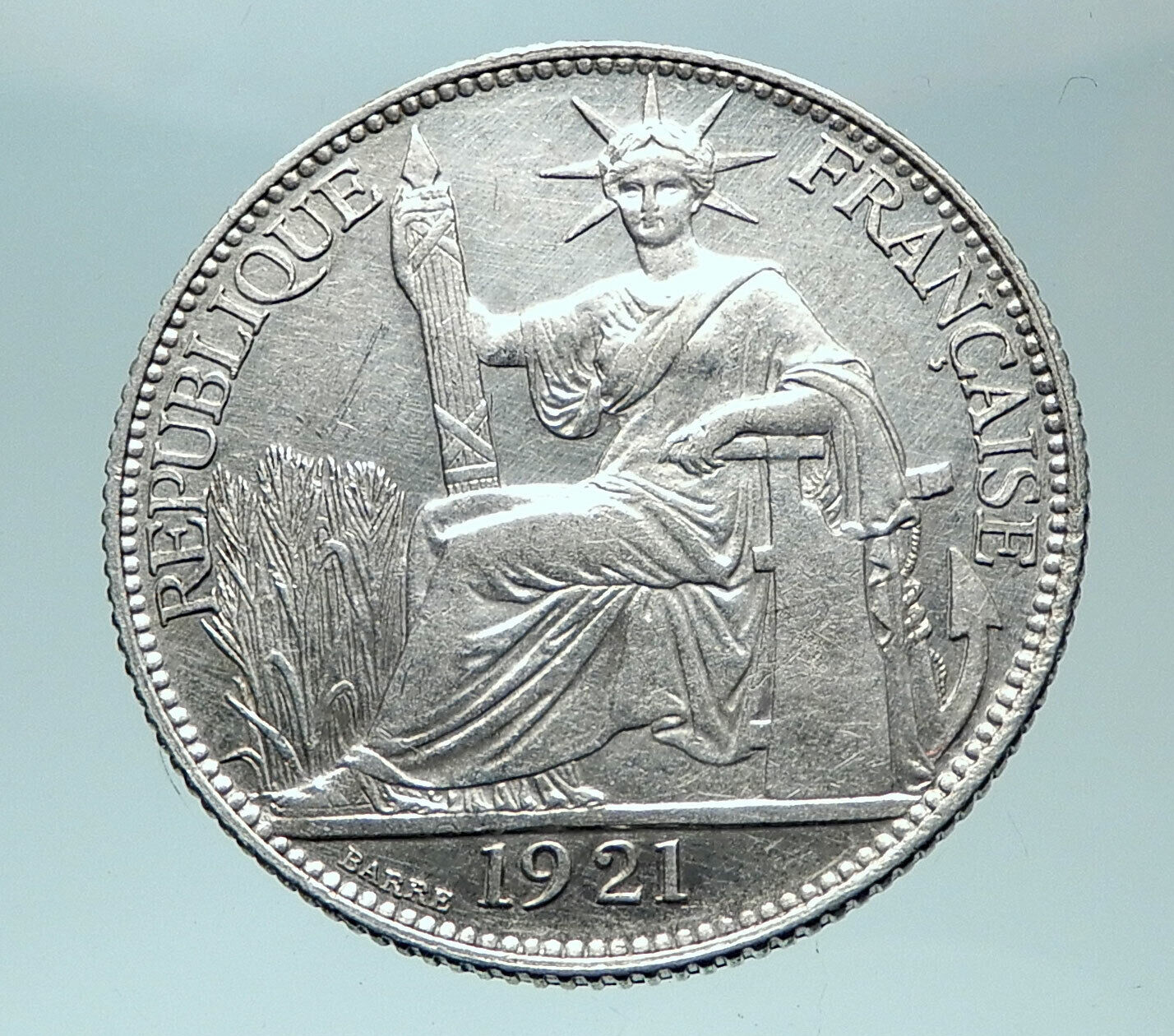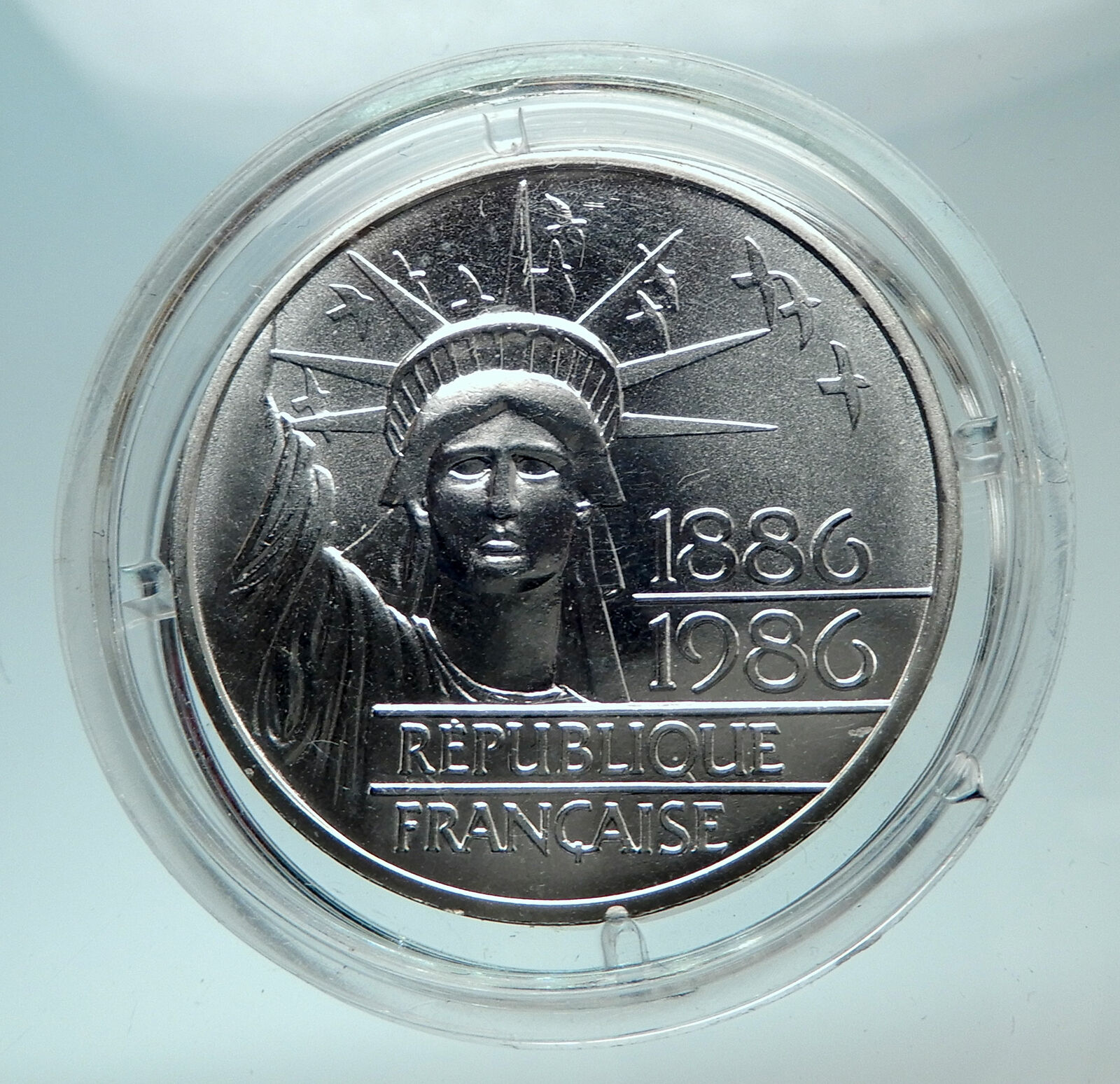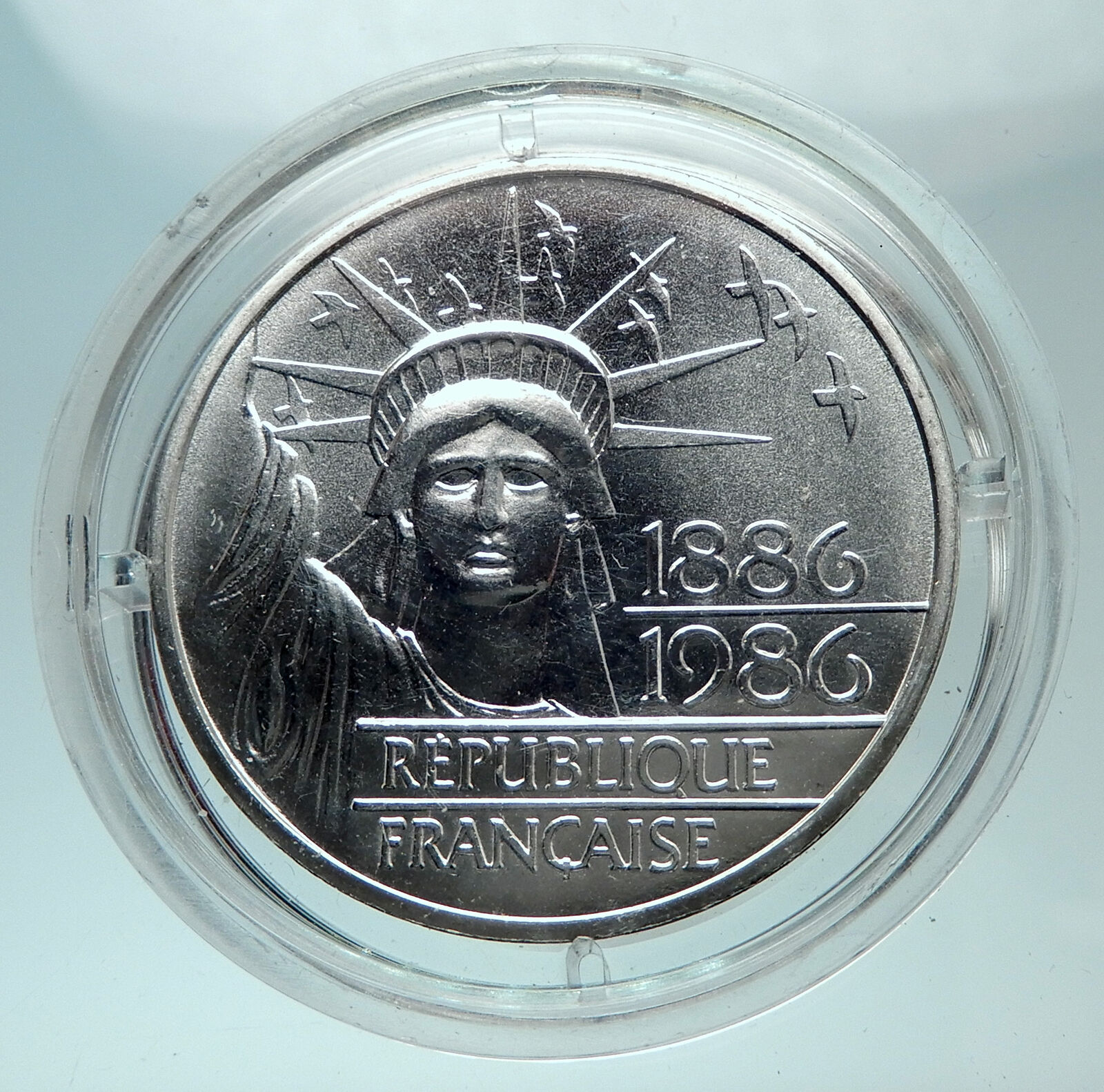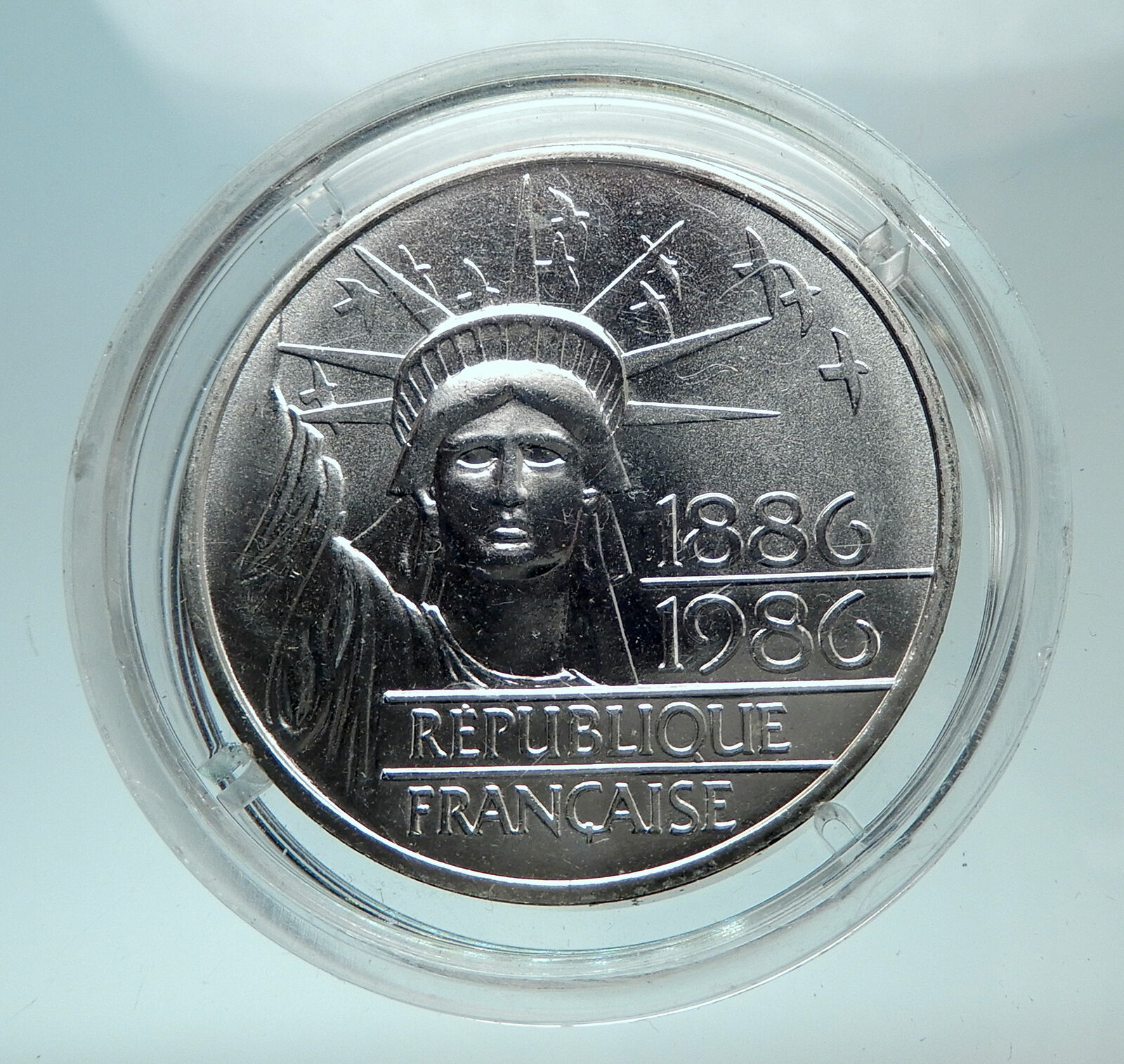|
France
1972 Nickel 1 Franc 24mm (6.04 grams)
Reference: KM# F# 226, Gad# 474, KM# 925.1, Schön# 233 (1959-2001) | Engraver: Louis-Oscar Roty
REPUBLIQUE FRANÇAISE O. Roty, The Sower, designed by Oscar Roty in 1900, a national emblem of the French Republic.
LIBERTE·EGALITE·FRATERNITE 1 FRANC, Olive branch is surrounded with the French motto.
You are bidding on the exact item pictured, provided with a Certificate of Authenticity and Lifetime Guarantee of Authenticity.
Liberté, égalité, fraternité, French for “liberty, equality, fraternity”, is the national motto of France and is an example of a tripartite motto. Although it finds its origins in the French Revolution, it was then only one motto among others and was not institutionalized until the Third Republic at the end of the 19th century. Debates concerning the compatibility and order of the three terms began at the same time as the Revolution.
 Louis-Oscar Roty usually known as Oscar Roty (11 June 1846 – 23 March 1911) was one of the most celebrated medallists of the Art Nouveau period. Louis-Oscar Roty usually known as Oscar Roty (11 June 1846 – 23 March 1911) was one of the most celebrated medallists of the Art Nouveau period.
Louis-Oscar Roty was born on 11 June 1846 in Paris. He first studied painting and sculpture, working under Lecoq de Boisbaudran, Augustin-Alexandre Dumont and François-Joseph-Hubert Ponscarme. Ponscarme (1827-1903), his mentor, was largely responsible for the renewal of medallic art at the end of the nineteenth century. In 1867 he had abandoned the medal rim in his design for his medal of Naudet, the background and graphics becoming part of the sculpture. Roty, along with Champlain, Alexandre Charpentier, and others, influenced by the Art Nouveau movement, advanced this resurgence of art in medal design. Roty, in particular, introduced the Renaissance form of the plaquette, which further emphasized the significance of the medal as a work of art. He designed hundreds of art medals celebrated for their graceful designs.

Charlotte Ragot, model from Oscar Roty for his “La Semeuse”
Following some difficulties early in his career, in 1882 Roty won the second prize in the Prix de Rome. This success was followed by many others, including the Grand Prix de Rome in 1875 and the Grand Prix at the 1889 Exposition Universelle in Paris. He was appointed to the rank of Professor in the Académie des Beaux-Arts in 1888, and in 1897 became its President. In 1889 he became an Officer in the Legion of Honor and rose to Cammander in 1900. At the height of his career, he was awarded the Medal of Honor at the Salon in 1905. In 1878 Oscar Roty married Marie Boulanger, daughter of the wrought iron craftsman Pierre Boulanger.
Besides a huge number of medals and plaquettes, Roty is well known as the designer of the “Semeuse” image on French silver coins and stamps. His medallic art can be found in nearly all European museums. A large number of his medals and plaquettes can be viewed in the Kunsthalle Hamburg and the Musée Oscar Roty in Jargeau, France.
Dr. George F. Kunz wrote about his contributions to the Medallic Arts.
  France, officially the French Republic (French: République française), is a sovereign state comprising territory in western Europe and several overseas regions and territories. The European part of France, called Metropolitan France, extends from the Mediterranean Sea to the English Channel and the North Sea, and from the Rhine to the Atlantic Ocean. France spans 640,679 square kilometres (247,368 sq mi) and has a total population of 67 million. It is a unitary semi-presidential republic with the capital in Paris, the country’s largest city and main cultural and commercial centre. The Constitution of France establishes the state as secular and democratic, with its sovereignty derived from the people. France, officially the French Republic (French: République française), is a sovereign state comprising territory in western Europe and several overseas regions and territories. The European part of France, called Metropolitan France, extends from the Mediterranean Sea to the English Channel and the North Sea, and from the Rhine to the Atlantic Ocean. France spans 640,679 square kilometres (247,368 sq mi) and has a total population of 67 million. It is a unitary semi-presidential republic with the capital in Paris, the country’s largest city and main cultural and commercial centre. The Constitution of France establishes the state as secular and democratic, with its sovereignty derived from the people.
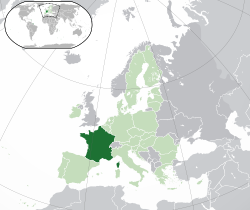
During the Iron Age, what is now Metropolitan France was inhabited by the Gauls, a Celtic people. The Gauls were conquered in 51 BC by the Roman Empire, which held Gaul until 486. The Gallo-Romans faced raids and migration from the Germanic Franks, who dominated the region for hundreds of years, eventually creating the medieval Kingdom of France. France emerged as a major European power in the Late Middle Ages, with its victory in the Hundred Years’ War (1337 to 1453) strengthening French state-building and paving the way for a future centralized absolute monarchy. During the Renaissance, France experienced a vast cultural development and established the beginning of a global colonial empire. The 16th century was dominated by religious civil wars between Catholics and Protestants (Huguenots).
France became Europe’s dominant cultural, political, and military power under Louis XIV. French philosophers played a key role in the Age of Enlightenment during the 18th century. In 1778, France became the first and the main ally of the new United States in the American Revolutionary War. In the late 18th century, the absolute monarchy was overthrown in the French Revolution. Among its legacies was the Declaration of the Rights of Man and of the Citizen, one of the earliest documents on human rights, which expresses the nation’s ideals to this day. France became one of modern history’s earliest republics until Napoleon took power and launched the First French Empire in 1804. Fighting against a complex set of coalitions during the Napoleonic Wars, he dominated European affairs for over a decade and had a long-lasting impact on Western culture. Following the collapse of the Empire, France endured a tumultuous succession of governments: the monarchy was restored, it was replaced in 1830 by a constitutional monarchy, then briefly by a Second Republic, and then by a Second Empire, until a more lasting French Third Republic was established in 1870. By the 1905 law, France adopted a strict form of secularism, called laïcité, which has become an important federative principle in the modern French society.
France reached its territorial height during the 19th and early 20th centuries, when it ultimately possessed the second-largest colonial empire in the world. In World War I, France was one of the main winners as part of the Triple Entente alliance fighting against the Central Powers. France was also one of the Allied Powers in World War II, but came under occupation by the Axis Powers in 1940. Following liberation in 1944, a Fourth Republic was established and later dissolved in the course of the Algerian War. The Fifth Republic, led by Charles de Gaulle, was formed in 1958 and remains to this day. Following World War II, most of the empire became decolonized.
Throughout its long history, France has been a leading global center of culture, making significant contributions to art, science, and philosophy. It hosts Europe’s third-largest number of cultural UNESCO World Heritage Sites (after Italy and Spain) and receives around 83 million foreign tourists annually, the most of any country in the world. France remains a great power with significant cultural, economic, military, and political influence. It is a developed country with the world’s sixth-largest economy by nominal GDP and eight-largest by purchasing power parity. According to Credit Suisse, France is the fourth wealthiest nation in the world in terms of aggregate household wealth. It also possesses the world’s second-largest exclusive economic zone (EEZ), covering 11,035,000 square kilometres (4,261,000 sq mi).
French citizens enjoy a high standard of living, and the country performs well in international rankings of education, health care, life expectancy, civil liberties, and human development. France is a founding member of the United Nations, where it serves as one of the five permanent members of the UN Security Council. It is a member of the Group of 7, North Atlantic Treaty Organization (NATO), Organisation for Economic Co-operation and Development (OECD), the World Trade Organization (WTO), and La Francophonie. France is a founding and leading member state of the European Union (EU).
|





 Louis-Oscar Roty usually known as Oscar Roty (11 June 1846 – 23 March 1911) was one of the most celebrated medallists of the Art Nouveau period.
Louis-Oscar Roty usually known as Oscar Roty (11 June 1846 – 23 March 1911) was one of the most celebrated medallists of the Art Nouveau period.

 France, officially the French Republic (French: République française), is a sovereign state comprising territory in western Europe and several overseas regions and territories. The European part of France, called Metropolitan France, extends from the Mediterranean Sea to the English Channel and the North Sea, and from the Rhine to the Atlantic Ocean. France spans 640,679 square kilometres (247,368 sq mi) and has a total population of 67 million. It is a unitary semi-presidential republic with the capital in Paris, the country’s largest city and main cultural and commercial centre. The Constitution of France establishes the state as secular and democratic, with its sovereignty derived from the people.
France, officially the French Republic (French: République française), is a sovereign state comprising territory in western Europe and several overseas regions and territories. The European part of France, called Metropolitan France, extends from the Mediterranean Sea to the English Channel and the North Sea, and from the Rhine to the Atlantic Ocean. France spans 640,679 square kilometres (247,368 sq mi) and has a total population of 67 million. It is a unitary semi-presidential republic with the capital in Paris, the country’s largest city and main cultural and commercial centre. The Constitution of France establishes the state as secular and democratic, with its sovereignty derived from the people.


